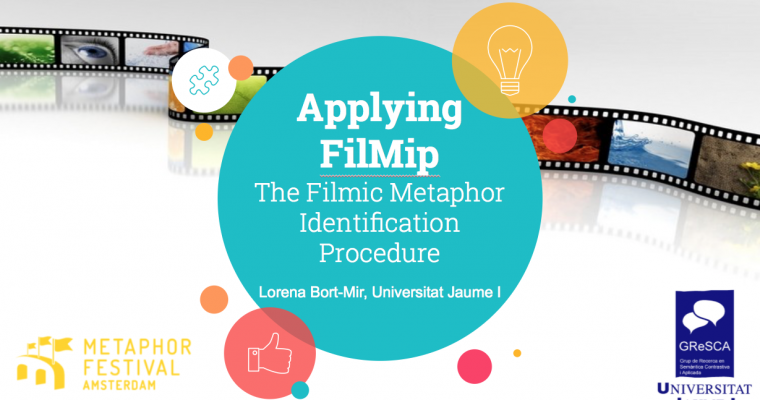ABSTRACT
FILMIP is an acronym that stands for Filmic Metaphor Identification Procedure.
The analysis and identification of figurative language is one of the largest research areas in cognitive linguistics, and metaphor is one of these tropes. Several methods have been designed in order to identify metaphor in discourse such as MIP, the Metaphor Identification Procedure (Pragglejaz Group 2007) and MIPVU (Steen et al. 2010). Diverging from spoken and written language, a seven-step method for the identification of metaphorically-used visual units in still pictures was developed by Šorm & Steen (VISMIP, 2018) . The method allows scholars to resolve whether certain images are interpreted through the construction of metaphorical comparisons.
With an overview of the main tenets of metaphor theory, multimodality, and film theory, I approach the study of filmic texts under the premises of cognitivism in order to construe a structural method for the identification of metaphorical components used in films.
FILMIP is presented in this study under the development of three stages:
- Theoretical development of the procedure with a detailed description of its corresponding steps. A summary of FILMIP is included below:
The first step to reach a general understanding of the film is developed by (i) viewing the video 5 times at least (content assessment), (ii) segmenting the clip into sequences, scenes, and shots to make the video analyzable with these smaller parts, (iii) identifying and describing the modes, and (iv) describing the referential meaning.
Once step 1 is finished, the analyst must then structure the referential description according to Tam and Leung’s (2001) annotation tool for visual materials in order to simplify the referential description for the following steps.
The procedure continues with step 3 with the identification of incongruous filmic components that must later be replaced by congruous elements in step 4.
Step 5 tests if those incongruous and congruous elements can be seen as some form of comparison within the overall topical framework of the video.
Step 6 tests if that comparison is cross-domain with Wordnet, an online big database of English words (nouns, verbs, adjectives, and adverbs) which are grouped according to their meanings (Šorm & Steen, 2018).
Finally, step 7 leads the analyst to the final decision: the film is marked for metaphoricity if steps 4, 5 and 6 are positive, otherwise it is understood that there are no metaphor-related filmic elements in the video.
- Practical application of FILMIP to real data (Chapter 4), where the method is applied to five TV commercials to exemplify its mechanism. The filmic ads of the corpus belong to perfume brands, and they were chosen under this criterion because of the usual metaphoric representation of the sense of smell, thus assuming that advertising campaigns of perfumes would make more use of metaphorical constructions than others. The corpus is created and analyzed with the use of the content analytic software Atlas.ti 8.2.4. The use of this qualitative data analysis software allows to properly segment the filmic ad in the corresponding units, to identify, classify and analyze all the modes, and to draw interesting networks on different variables, such as co-occurrence of modes with other elements or easy visualization of shots.
- Experimental testing, embedded within two different studies to check the procedure’s reliability:
(i) A content analysis with reliability tests (kappa and alpha coefficients) to categorize and code the semantic results after the individual application of the method by analysts.
(ii) A qualitative analysis to check percentage of agreement among analysts about the type of filmic components identified as metaphorically-used.
The results of these tests are evaluated as highly significant (Landis and Koch’s (1977; Neuendorf, 2002) with positive reliability rates (mean alpha and kappa values of 0.87 and 0.89).
This thesis presents FILMIP, the Filmic Metaphor Identification Procedure, as a valid and reliable tool for the identification of metaphorically-used filmic components within the genre of TV advertising, offering a valuable contribution not only to metaphor scholars but also to researchers focused on other fields of study such as multimodality, discourse analysis, communication, branding, or even film theory.
The aim of this website is to introduce a method that may constitute a reliable tool than can be used by scholars interested in different areas of study: semiotics, cognitive linguistics, discourse analysis, or even brand communication.
NOTE: I am currently applying the method to other genres. For the application of FILMIP in other cinematographic genres, please contact me 🙂
REFERENCES
Landis, J. R., & Koch, G. G. (1977). The measurement of observer agreement for categorical data. Biometrics, 159-174.
Neuendorf, K. A. (2002). The content analysis guidebook. Thousand Oaks, CA: Sage Publications.
Pragglejaz Group (2007). MIP: A method for identifying metaphorically used words in discourse. Metaphor and Symbol, 22(1), 1-39. doi: 10.1080/10926480709336752
Šorm, E., and G.J. Steen (2018). VISMIP: Towards a method for visual metaphor identification. In G.J. Steen (Ed.). Visual Metaphor: Structure and Process. Amsterdam: Benjamins.
Steen, G. J., Dorst, A. G., Herrmann, J. B., Kaal, A., Krennmayr, T., & Pasma, T. (2010). A Method for Linguistic Metaphor Identification: From MIP to MIPVU. Amsterdam (Netherlands): Benjamins.
Tam, A. M., & Leung, C. H. C. (2001). Structured natural‐language descriptions for semantic content retrieval of visual materials. Journal of the American Society for Information Science and Technology, 52(11), 930-937.
